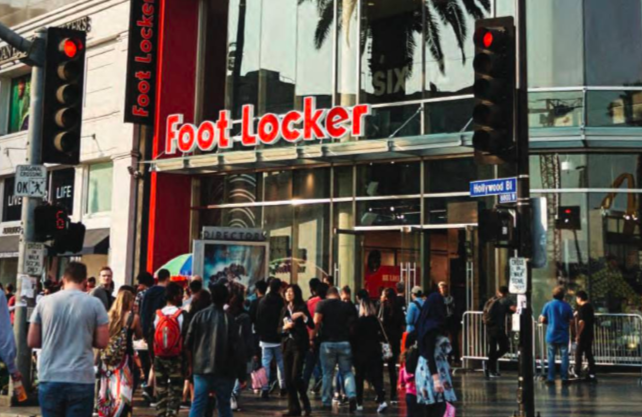Foot Locker Inc. reported third-quarter earnings that topped Wall Street’s targets as greater full-price selling boosted margins. The sneaker chain also gave an upbeat outlook on holiday selling on improving comp growth.
“At the beginning of 2018, we laid out our expectations for sequential improvement through each quarter of the year, with comparable sales turning positive in Q2 and then accelerating in Q3 and Q4,” said Dick Johnson, CEO, on a conference call with analysts. “I’m pleased that our team’s strong efforts led to a third quarter performance in line with these expectations, and we believe position the company to deliver even stronger results in Q4.”
Net earnings in the quarter before non-recurring items were down 1.8 percent to $108 Million, or 95 cents per share, but topped Wall Street’s consensus estimate of 92 cents. A significant reduction in shares outstanding to 115.0 million in the latest quarter from 126.4 million a year ago led to a 9 percent gain on an EPS basis from 87 cents a year ago.
Net results included charges related to litigation judgment and unusual tax items. Net income came to $130 million, or $1.14, compared to net income of $102 million, or 81 cents, in the same period a year ago.
Comps increased 2.9 percent. Total sales decreased 0.5 percent to $1.86 billion due to the 53-week calendar shift, but exceeded Wall Street’s consensus estimate of $1.85 billion. Excluding the effect of foreign exchange rate fluctuations, sales inched up 0.4 percent.
Gross margins increased to 31.6 percent from 31.0 percent a year ago. On a conference call with analysts, Lauren Peters, EVP and CFO, said more full price selling during the period led to the gross margin improving above expectations.
The 60 basis improvement in gross margin was tied to 80 basis points in improvement in merchandising margin due to “meaningfully lower markdowns.” The progress was partially offset by lower initial market rate, and the continuing promotional environment in our European markets.
Continuing to hold back earnings is climbing SG&A expenses, which increased to 21.4 percent of sales from 19.7 percent in the third quarter of 2017. In addition to the impact of the 53rd-week shift, planned investments in digital capabilities and logistics, and higher incentive compensation impacted the SG&A rate.
Peters said the 2.9 percent comparable sales gain during the third quarter marked the company’s best quarterly results of the year and were in line with previous guidance.
By month, August was up low-single digits followed by mid-single digit comp gains in both September and October. Comps grew 2.4 percent at its stores and 5.9 percent across digital. As a percent of total sales, DTC was 14.5 percent for the quarter, up from 13.8 percent last year.
Sequential improvement was seen in traffic, led by a modest increase at its U.S. store banners. International traffic was down low single-digit although that still marked sequential improvement with “notable progress” at Foot Locker Europe. Average selling prices continue to move higher, both in footwear and apparel; unit sales were also up in footwear while apparel units were down a few ticks.
Among categories, footwear turned positive and posted its first comp gain in six quarters with a low single-digit increase. The strong trend in apparel continued with a high single-digit comp gain fueled by branded assortments. Accessories such as hats and socks comped down double-digits.
Within footwear, women’s was the strongest performer with comps up double-digits. Men’s was up low-single digits, and kids was up slightly. Men’s running comps were up double-digits and while basketball was down mid-single digits, the trend did get better from the second quarter. Casual footwear and seasonal assortment such as boots had another solid quarter, posting a mid-single digit comp gain.
Apparel’s high single-digits gain was supported by strong gains across most geographies, banners and size ranges. Children’s apparel was up strong double-digits, men’s apparel posted a solid high single-digit gain, while women’s was up low single-digits.
Johnson noted that within women’s, Foot Locker overall saw strong performances across most banners, where improved footwear and apparel assortments are resonating with consumers.
Among banners, Foot Locker U.S., Champ Sports and East Bay led the way in North America, each up mid-single digits. SIX:02 and Foot Locker Canada each saw low single-digit gains. Kids Foot Locker was down slightly while Foot Action was down mid-single digits, primarily due to an ongoing reset with the Jordan brand.
In international markets, Foot Locker Europe generated a mid-single digit comp increase driven by gains across footwear and apparel. Foot Locker Pacific posted a low single-digit gain while Sidestep was down mid-single digit, and Runners Point declined high single-digit. New Asia stores in Hong Kong and Singapore saw “some encouraging sales,” said Peters.
Inventory decreased 0.6 percent compared to an overall sales decrease of 0.5 percent. On a constant currency basis, inventory increased 0.5 percent compared to a 0.4 percent sales increase.
Said Peters, “Due to this year’s holiday shift, Thanksgiving falls a week earlier than last year, we strategically slowed additional receipts and at the end of the third quarter to position us for the start of the holiday selling period, which for us began this past Saturday with the kick-off of our annual week of greatness.”
For the fourth quarter, the company now expects:
- Comparable sales to be up low to mid-single digits, a slight increase over the prior low single-digit guidance;
- Gross margin to improve by 100 to 130 basis points compared to a 13-week quarter last year
- SG&A on a 13-week comparative basis to increase 100 to 120 basis points as a rate of sale.
Said Peters, “In total, this results in a solid double-digit EPS gain for the fourth quarter.”
With the year-to-date improvement with year-to-date comps now ahead 0.1 percent, Foot Locker remains on-track to achieve the annual top and bottom line guidance, including a low-single digit comparable sales increase and a double-digit EPS gain.
Image courtesy Foot Locker
















